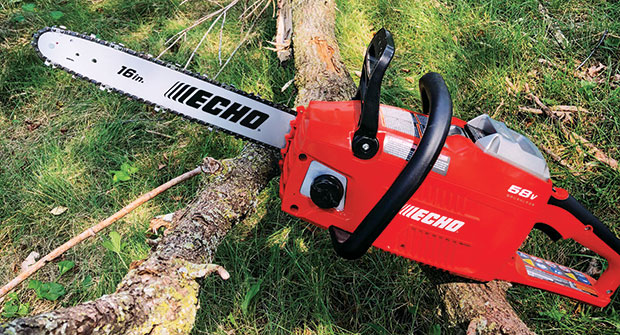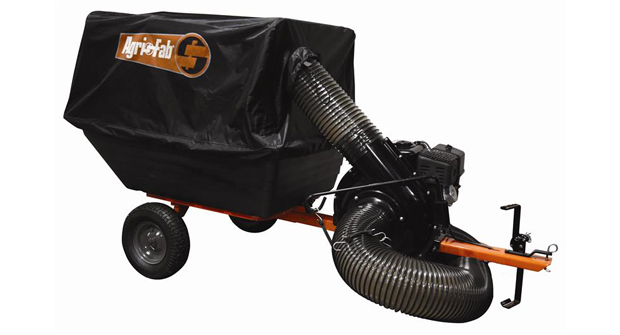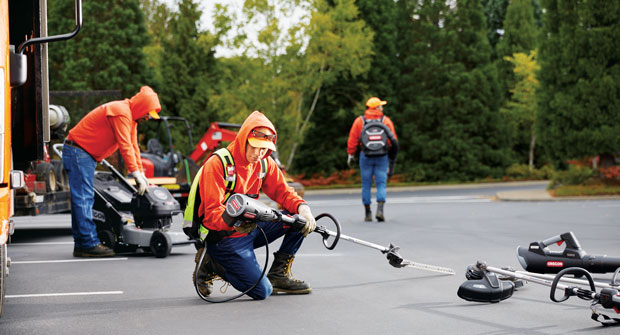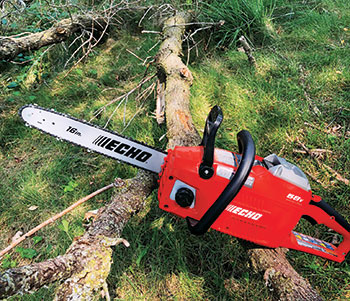
Environmental concerns, potential safety hazards and fuel costs — all have been cited as reasons landscape contractors make the switch over to battery-powered handheld equipment from gas-powered machines.
“We are responsible for the upkeep and improvement of the cultivated landscape, and I think that is best completed with the very light touch (of battery-powered equipment),” says Matt Dingeldein, president of Oak Grove Gardeners in Naperville, Ill.
Landscape Management got the scoop from Dingeldein and two other landscape professionals — Chris Draaistra, owner and general manager of The Grounds Guys of Abbotsford in British Columbia, and Michael Bedell, owner of Bedell Property Management in Milford, Mich. — on why battery-powered equipment is the go-to option for them.
A new solution
Bedell Property Management, a site development consulting, horticulture, landscape design/build and snow and ice management firm, began using an Echo CCS-58V4H cordless chainsaw during the 2019 growing season. After experiencing issues with the gas-powered chainsaws it had previously used, the company followed the advice of several other contractors in its area.
“Struggling to get gas-powered equipment going that’s sat for a while can really kill the profitability of a project,” Bedell says. “Battery-powered equipment can sit idle for months, and as long as there is a charge in the battery, we can pull that equipment off the shelf and get it started without a hassle, allowing us to service our clients in a more timely and profitable manner.”
While battery-powered equipment has enabled Bedell Property Services to be more productive on the high-end residential and commercial properties that it services, Bedell cautions that crews should be sure to have an additional fully charged battery on hand to keep projects moving.
“While the amount of work you can complete with one fully charged battery is impressive, some projects will certainly take more battery power than a single charge offers,” he says.
With the 2019 season drawn to a close, Bedell says he looks to implement more battery-powered technology in 2020.
“The efforts of many top manufacturers these past few years in developing next-level battery-powered equipment is starting to show dividends for us
as the end user — and this is just the beginning,”
he says.
Maintenance managed
For The Grounds Guys of Abbotsford, the change to battery-powered machines came after technicians struggled to keep gas-powered handheld equipment up and running.
“Our techs are not mechanics or mechanical, and the switch to battery-powered equipment seemed like a simple solution,” Draaistra says.
The company made the commitment to invest in Stihl 3.0-Ah battery-powered equipment — including hedge trimmers, pole saws and chainsaws — for all five of its crews in early spring 2019. The company has also recently embarked on a trial with Makita’s battery-powered equipment.
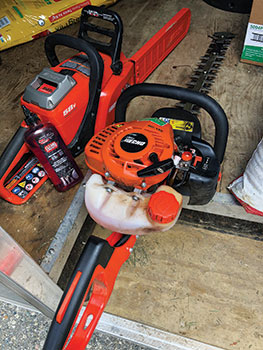
In addition to the machines, The Grounds Guys of Abbotsford invested in two batteries per trailer, as well as a charging station at the shop.
Overall, Draaistra says implementing battery power into his operation has allowed his company to not have to worry about fumes, fuel or ear protection because the equipment operates quietly, a perk for the homeowners’ association properties the company helps maintain.
He adds that crew members can operate the machinery in a safer manner.
“When you put the machine down, it turns off immediately. There are no moving chains on a hedge trimmer or saw, and the techs are not trying
to keep a machine running while doing another task,” he says.
The final perks of battery-powered equipment, Draaistra says, is that the equipment produces no carburetor, valve or flooding issues.
“We use these in the rain all day long (about four to five months of the year),” he says. “I really can’t say enough about this equipment.”
Giving it a go
Oak Grove Gardeners warmed up to the idea of battery-powered equipment after being presented with an opportunity by Ego’s product research team to test out Ego’s products in spring 2019.
The company has since incorporated two hedge trimmers, two string trimmers, two leaf blowers, one sidewalk edger, three high-capacity backpack-mounted batteries and two 21-inch mowers into its fleet.
So far, the equipment has exceeded Dingeldein’s expectations.
“I’m bought and sold,” he says. “(The machines) are just an incredible production tool. (Using them) was a huge boost for us. Not having to breathe exhaust fumes, from a worker’s perspective and for workers’ health and safety, is a huge leap forward.”
Dingeldein says during the regular growing season, his crews haven’t had issues, but in the fall, the leaf blower doesn’t quite have the capacity to keep up with the demand.
“The full power of the blower’s battery will run about as long as a tank in a two-cycle mix in a comparable gas model, but the problem is you can’t always recharge on the fly,” he says. “(However), we do usually get through the production day with more than enough power to make it back to the shop.”
The company currently has three wall-mounted chargers that hang in the maintenance trailer, connected to a heavy-duty power strip, which is then connected to a wall outlet via an extension cord.
Chargers for smaller batteries can be charged overnight in the office or in the field.
Oak Grove Gardeners hasn’t completely flipped over to all battery-powered equipment, and Dingeldein says the only thing holding his company back is the cost. As of now, a battery-powered 60-inch zero-turn mower is about double the price of a comparable gas model.
“It does cost a little bit more upfront, but we don’t go to the gas station (for the equipment),” he says. “But I think between the reduced carbon footprint and reduced noise, it’s also a lot less disruptive.”
For contractors who are thinking about adding battery-powered machines to their operation, Dingeldein encourages them to test it out.
“The best advice I would have for somebody wanting to put their foot in the water is to just try. Start with a line trimmer or hedge trimmer and really see how much of a difference it can make in your fleet,” he says. “I look forward to the day when the technology is a little more widespread.”
